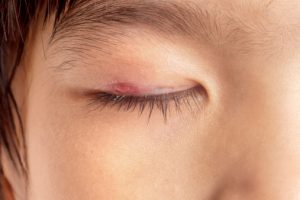A stye is a red bump that develops either on the inside or the outside of your eyelid. Styes can be tender and cause minor irritation, but they are usually not serious.
Similar to how you get a pimple on your face is how you can get a stye on your eye; it is simply the result of the gland along your eyelid becoming clogged.
Signs that you have developed a stye include:
- Redness and tender feeling near your eyelid
- You develop a bump with a small pus spot in the center
- You have a sensation that there’s something in your eye
- Your eye feels sensitive to bright light
- There is crust along your eyelid
- You have a scratchy or itchy feeling around the eye
- Your eye produces extra tears
Styes typically burst and go away on their own after a few days. But there are a few tips to treat your stye and minimize some of the symptoms.
- Soak a clean washcloth in warm water and put it over the stye for approximately five to ten minutes and repeat several times per day.
- Clean your eyelid with a cotton swab soaked in a mild baby shampoo. Avoid using harsh soaps as they can irritate and burn your eye.
- Resist the urge to squeeze or pop your stye. This will only make the situation worse.
- Keep your face and eyes very clean, and get rid of any crust you see around your eye.
- If you are experiencing soreness around the eye, you can take a pain reliever, such as ibuprofen.
- Avoid wearing eye make-up
- If you wear contacts, try switching to glasses. After the stye has healed, make sure you clean and disinfect your contacts or replace them with a new pair.
You shouldn’t have to see your doctor for a stye. But it’s a good idea to make an appointment if your stye doesn’t get better after a few days, if you are in a great deal of pain, or if it affects your vision.
To see a doctor at Flushing Hospital Medical Center’s Ambulatory Care Center, please call 718-670-5486.
All content of this newsletter is intended for general information purposes only and is not intended or implied to be a substitute for professional medical advice, diagnosis or treatment. Please consult a medical professional before adopting any of the suggestions on this page. You must never disregard professional medical advice or delay seeking medical treatment based upon any content of this newsletter. PROMPTLY CONSULT YOUR PHYSICIAN OR CALL 911 IF YOU BELIEVE YOU HAVE A MEDICAL EMERGENCY.

